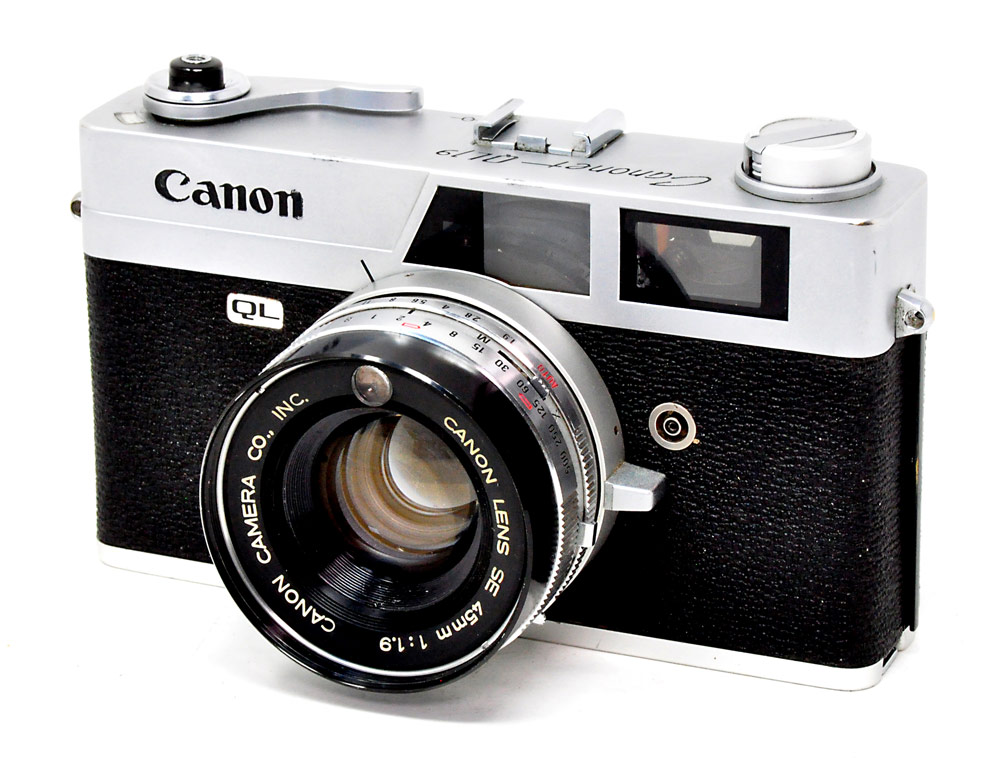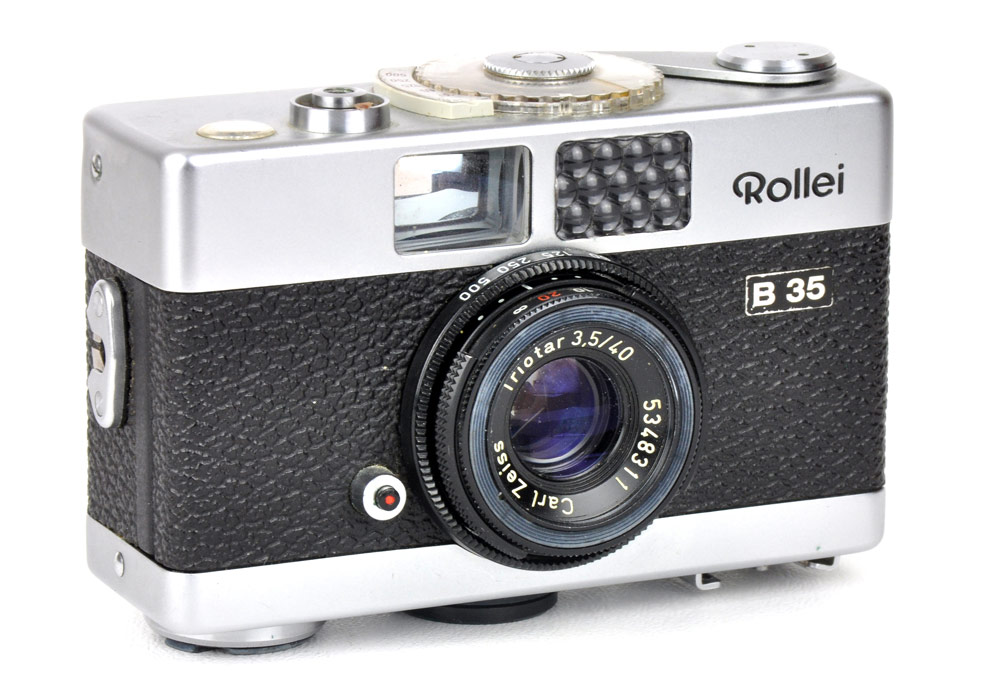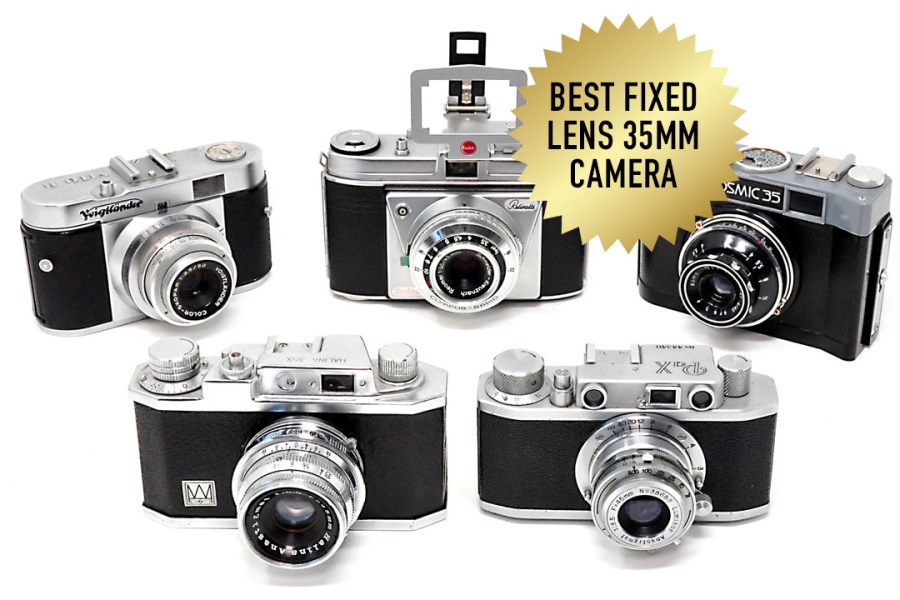The rise of the 35mm single lens reflex (SLR) in the 1960s pretty much marked the end of the interchangeable lens rangefinder camera era. There had, however, been another type of non-reflex 35mm camera around pre-1960 that ran alongside the SLR revolution to remain popular even into the 1980s. We’re talking about fixed-lens 35mm viewfinder and rangefinder cameras.
Some offered a degree of automation with selenium cell metering, which ran without a battery; others used CdS meters, which did need batteries, but with manual override using mechanical shutters that operated without batteries; and of course there were cameras without any automation or metering at all.
Whichever way you look it, cameras like these are today affordable, easy to use… and can do it all without a battery.
John Wade takes you back to basics with some of the best fix lens 35mm film camera classics…
Best fixed lens 35mm film cameras – Canonette
Canonette QL19
Second-hand price | £40-70 / $30-70 approx.

Canonette QL19, equally at home when used automatically or manually. Photo credit: John Wade
The original Canonette from 1961 is characterised by a selenium meter cell around its lens to provide auto as well as manual control. So no batteries.
In 1964, Canon switched the Canonette to CdS metering, but throw away the battery and turn the aperture scale away from its ‘auto’ setting and you have a fully manual camera. As an example, take the Canonette QL19 from 1965. It sports a 45mm f/1.9 Canon Lens SE and mechanical shutter speeds of 1-1/500sec. The lens is coupled to a coincident image rangefinder in the viewfinder whose field of view is shown by a bright-line frame that moves as the lens is focused to allow for parallax.
The ‘QL’ in the camera’s name indicates it uses Canon’s Quick Load film system.
Best fixed lens 35mm film cameras – Olympus
Olympus – Trip 35
Second-hand price | £40-70 / $70-80 approx.

Olympus Trip, one of the world’s most successful cameras. Photo credit: John Wade
Among many Olympus fixed lens 35mm cameras, the Trip, from 1967, is probably the best known. Set the aperture ring to ‘A’ and the selenium cell meter around the lens automates apertures of f/2.8-f/22 with two shutter speeds of 1/40sec and 1/200sec. Apertures can be set manually for flash photography and focus is indicated by markings from 3 feet to infinity below the lens or by four pictograms above.

Olympus 35RC added a rangefinder to aid focusing. Photo credit: Joe Haupt CC BY 2.0 via Wikimedia Commons
Olympus 35RC
Second-hand price | £100-150 / $80-130 approx.
Or how about the 1970 Olympus 35RC? About the same size as the Trip, it has the added advantage of a coupled rangefinder. Forget the CdS metering and battery and you’ve still got a good, usable manual camera. The shutter is set by a dial on the top plate, allowing flash synch at up to 1/500sec. The lens is a 42mm f/2.8 E. Zuiko.
Best fixed lens 35mm film cameras – Konica
Konica I / Konica II / Konica III
Second-hand price | £80-90 / $100-150 approx.

Konica I (left) and Konica Auto S2. Photo credit: John Wade
Konica might not be a name that springs immediately to mind when selecting a second-hand camera, but the company made some superb 35mm fixed lens models. The Konica I, II and III were made during the 1950s, each model with several variations and subtly different specifications. You’ll find them with f/3.5 or f/2.8 lenses and coupled rangefinders. As well as having old-fashioned knobs for film winding, they also show their age by having a shutter release and cocking mechanism on the rim of the lens.
Konica Auto S / Konica Auto S2 / Konica Auto S3
Second-hand price | £60-£280 / $80-300
For a more modern design, including lever film wind and top mounted shutter release, fast forward to the 1960s for the very stylish Konica Auto S, S2 and S3, all of which work manually. Other than having fixed lenses, these later Konicas resemble and handle a lot like a Leica M3.
Best fixed lens 35mm film cameras – Ricoh
Ricoh 500GX
Second-hand price | £25-40 / $40-70 approx.

Ricoh 500GX (left) and the 500ME with its clockwork motor drive fitted. Photo credit: John Wade
Ricoh is another name that has fallen by the wayside, but there is a series of neat little cameras worth considering in this marque. Take the Ricoh 500GX launched in 1976. At just 10.5x7x6cm and weighing in at a mere 450 grams, it’s very pocketable, sports a 40mm f/2.8 lens, multiple exposure control and a coupled rangefinder. Remove the battery and, again, you have a lovely little manual camera that was made in black or chrome.
Ricoh 500ME
Second-hand price | £20-30 / $80-100 approx.
Or, for something a little different, try the Ricoh 500ME from 1980 with a size, weight and specification very similar to the 500GX. The difference is it has a motor drive that bolts onto the baseplate. Surely that needs batteries? No – it runs by clockwork.
Best fixed lens 35mm film cameras – Rollei B-series
Rollei B35
Second-hand price | £35-50 / $90-180 approx.

Rollei B35, for semi-auto or manual use. Photo credit: John Wade
When it was launched in 1966, the Rollei 35 was the world’s smallest full-frame 35mm camera. Several models were subsequently made with battery driven CdS metering. The 35T and 35S were named to signify they used Tessa and Sonnar lenses; the 35TE and 35SE offered more advanced electronics.
But if you want a simple, no-battery experience, go for the Rollei B35. This has a built-in selenium cell exposure meter that deflects a needle in a dial on the top plate to suggest the correct aperture against a chosen shutter speed. Each is then set manually.

The B35 from the top, showing the metering system and with the lens extended for shooting. Photo credit: John Wade
Rollei C35
Second-hand price | £140 / $120 approx.
The alternative is the C35, which is totally manual without a meter. Both cameras use Triotar lenses. Be aware that the lens is pulled out and twisted to click-stop into its shooting position, but don’t try to push it back the same way. To retract the lens, the film must first be wound on and then a small stud to the side of the lens depressed. Also, loading the cameras is very fiddly.
Best fixed lens 35mm film camera for basic simplicity
We can’t leave this subject without dipping a toe back a little more into the past, to a time when cameras had fixed lenses, viewfinders but no rangefinders, no metering, offered manual operation as the only option and a battery was something you put in a torch, not a camera…
Pax 35 (1952)
Second-hand price | £25-35 / $20-50 approx.
Looking a lot like a Leica II only smaller, this was the first in a line of Pax cameras that stretched into the 1960s. It sports a 45mm f/3.5 coated triplet lens and shutter speeds of 1/10-1/300sec. Check carefully before buying because Pax focusing rings have a tendency to seize up.
Voigtländer Vito B (1954)
Second-hand price | £10-20 / $30-40 approx.
Here’s a palm-sized camera with a well-respected f/3.5 Color Skopar lens and shutter speeds of 1-1/500sec. The shutter is tensioned by the film turning a sprocket as it is wound on and so won’t fire without a film loaded.
Retinette (1955)
Second-hand price | £10-20 / $20-40 approx.
With the Kodak name behind it and an ancestry that started with the Retina, went on to folding Retinettes and finished with solid body variations, there’s not much to go wrong here. A great many variations were made, of which, the one illustrated has a 45mm f/3.5 Schneider Reomar lens, with apertures and shutter speeds set on rings around the rim.
There’s an option to lock both together to maintain the same exposure as f-stops or shutter speeds are changed. If the viewfinder is a little small for your tastes, look for the parallax-correctable sports finder that slips into the accessory shoe.
Halina 35X (1959)
Second-hand price | £10-15 / $10-20 approx.
Another small Leica look-alike, boasting shutter speeds of 1/25-1/200sec and a 45mm f/3.5 Halina lens whose quality, frankly, is adequate but not great. Beware of pressing the shutter release before tensioning the shutter with the lever beside the lens. Failure to do so means the interlock forces you to wind on to the next frame, leaving a blank one behind.
Cosmic 35 (1961)
Second-hand price | £15-20 / $10-20 approx.
A plastic body with fake leatherette covering doesn’t bode well, but this little camera, made in Leningrad, has won a favourable reputation for the quality of its 40mm f/4 lens. Shutter speeds run 1/15-1/250sec and the lens focuses down to 3 feet. The viewfinder is a bit squinty, but it’s a solid little camera that handles well and which attracted a great many fans throughout the 1960s.
Prices are based on eBay listings on the date of publishing and will likely fluctuate
Written by John Wade
Looking for more classic 35mm inspiration? Check out John Wade’s round-up of the best 35mm manual focus film cameras
Mountain Photography: Interview with mountain photographer Alan Hinkes
How to do film photography on a budget
Classic film cameras







